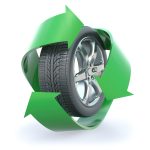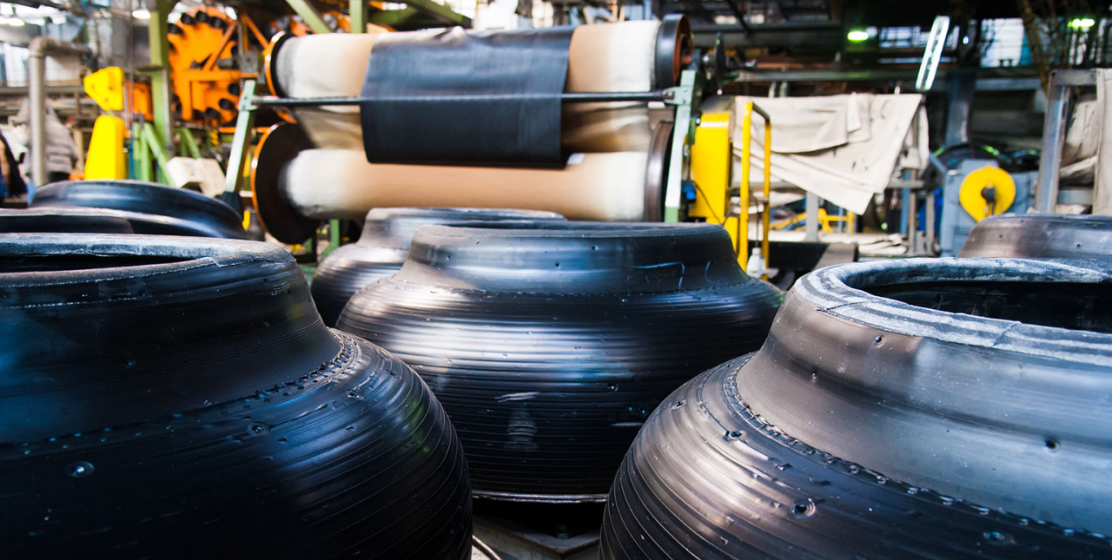
How Tires are Made: Blending chemistry, physics & engineering to make and recycle tires
Ever wonder how your car tires were made? The basic steps of tire manufacturing start with intensive planning and design to customize each tire model to meet the stresses and performance requirements to match a particular vehicle. The production process begins with the selection of several types of rubber along with special oils, carbon black, pigments, antioxidants, silica, and other additives that are combined to provide the exact characteristics for each class of tire. The assembly of the tire includes an inner liner, body plies and belts, bronze coated steel wire strands, and finally, tread and sidewalls. After being pressed together, the end result is called a “green” or uncured tire.
In the last step the green tire is placed inside a mold and inflated so it forms to the tread. Then it is heated to more than 300 degrees Fahrenheit for twelve to fifteen minutes, vulcanizing it to bond the components and cure the rubber. Tires are then inspected, and sample tires are randomly tested, x-rayed, cut apart to look for flaws, run on test wheels, or road-tested to evaluate handling, mileage and traction performance.
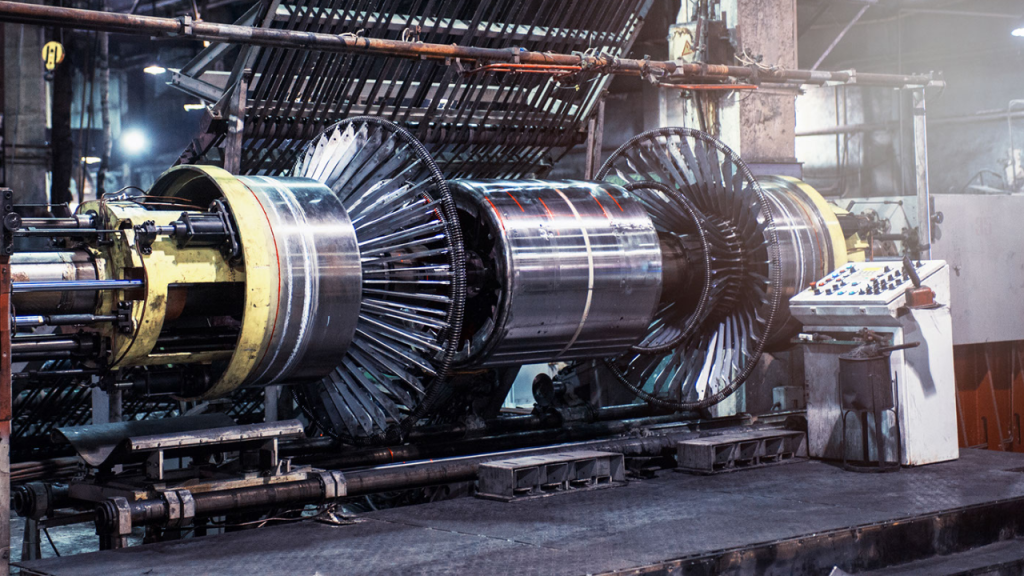
Tire manufacturing involves a custom five step process based on the tire type
The future of tires: sustainable, lighter, stronger & recycled
Sustainable
When an array of sophisticated materials and components are vulcanized to form a technologically advanced product, the end result is a tire that is indeed impressive. After roughly 4-5 years, as a set of tires reaches its end-of-life, they are removed and collected in preparation for processing and re-purposing into new materials.
The goal is to ensure that whatever goes into a tire can be renewed or re-used, providing a sustainable option to disposing of tires. This is a great example of the circular economy, where sustainable production has environmental, economic and social benefits. The four “Rs” of the circular economy all exist within tire recycling:
- Reduce: minimize waste
- Reuse: repair, salvage, remanufacture, second hand use
- Recycle: convert scrap materials into another commodity
- Recover: any materials that are difficult to segregate and recycle
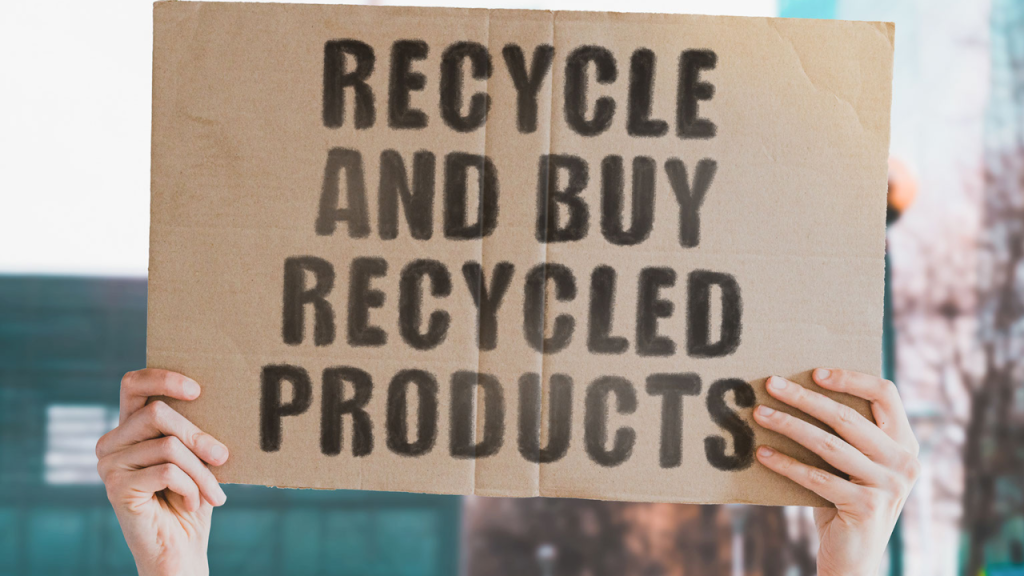
The four Rs of the circular economy: Reduce, Reuse, Recycle and Recover
Michelin is committed to making their tires 100% sustainable by 2050. This is an ambitious but realistic target for the Group, a leader in sustainable mobility. Here are some of the innovative ways our customers are moving towards holistic sustainability.
Developing Lighter, Longer-Lasting Tires
Tire manufacturers are developing ways to reduce tire mass on passenger tires. This could decrease the amount of material needed. In addition to this, by developing tread compounds that are more resistant to wear, tread mass is reduced while also providing a longer tire life cycle.
Developing High-Load Capacity Tires (HL Tires)
By combining science and engineering, tire manufacturers, in collaboration with auto makers, are designing and producing tires that can support heavier vehicle loads without increasing maximum tire pressure or size. “HL” tires are present in Europe and are currently being introduced to the North American market for SUV, electric and hybrid cars. These cars are typically built on the same size frame as standard cars but weigh more, so they require a higher load capacity tire. Goodyear’s Fortera HL tire is a great example of this.

Electric car at a charging station
Using Renewable Raw Materials
Making tires from renewable materials has always been a lofty goal for scientists. Now, together with tire manufacturers, scientists are researching ways to use renewable biomass; organic material that comes from plants and animals. Finding ways to recycle natural rubber and other renewable biomass will pave the way to using more sustainable raw materials in tire production.
Some of the research is focused on finding new varieties of rubber trees and other means to increase rubber yields. The goal is to secure rubber production today, as well as protect and enrich the natural rubber supply in the future. Tire manufacturers like Michelin partner with rubber plantations to implement both responsible and sustainable best practices. Manufacturers are also developing rubber plantations to reverse deforestation by planting rubber trees in previously clear-cut areas. (reference specific tire company)
One particularly interesting focus has been on using oils (e.g. sunflowers) and organic waste from plants. Plant based materials can be used to make bio butadiene, a type of synthetic rubber used in tires. Members of the Global Platform for Sustainable Natural Rubber are exploring the benefits of this approach.
A team from the University of Minnesota is perfecting a three-step chemical process that can produce isoprene from renewable biomass such as trees, grasses or corn. Isoprene, together with natural rubber, make up the main components of a tire. Economically bio-sourced isoprene has the potential to expand domestic production of car tires by using renewable, readily available resources instead of fossil fuels.

Trees corn & grass as potential biomass sources
Adding Recycled Components to Tires
Once used, the waste from polystyrene (think food containers and packaging) can be recycled into tires by mechanically breaking down the polystyrene into a powder, heated, and combined with bio-butadiene to create a sustainable synthetic rubber. With this technology, approximately 80,000 tons of polystyrene waste could be recycled into tires each year in North America.
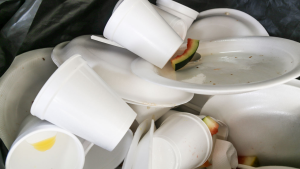
Polystyrene food containers & tire manufacturing
Another source of common waste that can be recycled into tires is PET plastic (think water, soda and juice bottles). It can be recovered and broken down with enzymes into base monomers, where the remaining components of the plastic can be reformed into polymer reinforcements in tires. Michelin predicts that up to four billion plastic bottles could be recycled into new tires each year.
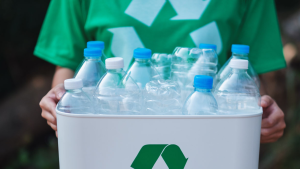
Recycling Plastic Bottles for Use in Tire Manufacturing
Turn Old Tires into New Products
Tire recycling technology can be used in support of a circular, sustainable economy. The gold standard is that EVERYTHING in an end-of-life tire could be recovered for reuse.
Currently, Michelin plans for as much as 90% of recovered materials to be reused in a variety of rubber-based products, such as tires, conveyor belts and anti-vibration products. The remaining 10% will be reused directly by manufacturing plants to generate heat and power. With this technology, 56 million tires could be recycled each year around the globe to make new Michelin tires.
Retreading Old Tires
For many medium-duty applications such as 18-wheel trucks and buses, a sustainable solution is retreading, or adding additional tread to reuse the remaining tire carcass. This can be economically advantageous and increases the overall lifespan of a tire. In future, reuse through retreading could become the standard in passenger cars as well.
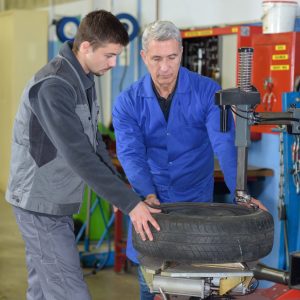
Apprentice mechanic and teacher retreading wheel in automotive workshop
Airless Tires
It is not the tire itself that supports the load of a vehicle, but rather the air trapped and compressed in the tire. Bridgestone is developing airless tires, where a structure made from sustainable materials supports the load. The hub and spoke stay the same, but the treads can then be changed out for later use or modified for different uses. When the tread reaches the end of life, it is recycled, and a new tread is attached.
Connected Tires
Imagine if your tires could communicate with your vehicle and you, providing information on the usage history of the tire, as well as road conditions. Tire manufacturers are introducing tires into the market equipped with a radio frequency identification (RFID) inserted into the tire sidewall. The tire has a unique identifier that provides information in separate secure databases so that tire manufacturers and service providers can track the history (and lifespan) of a tire.
Research is also underway on using electronics in tires to aid in the vehicle control system. This could be helpful when it comes to knowing how deep the water is on the road on a rainy day, or what the minimum stopping distance should be based on the tire tread.
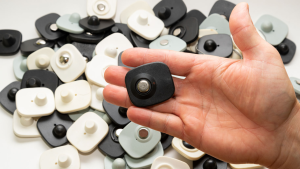
Tire manufactures are experimenting with adding RFID chips to tires to track their performance.
How we make tires affects how we recycle tires
The tire recycling industry is thriving in Ontario, as the market for products made from recycled tires is growing quickly. From gym mats to playgrounds, companies are creating innovative and inspiring options. The process starts at a processing facility, removing the rubber from the rim, separating the steel and fibre, and chopping the rubber into various grades of crumb. The crumb rubber is then sold to companies that repurpose it into new products.

TierraVerde™ unbreakable planters
Does high-tech design impact how we recycle tires?
As tires become more adaptive to environmental conditions and sophisticated in their safety and mobility features, it adds new layers of complexity in the recycling process. For example, how do we effectively remove RFIDs and other electronics from tires before they are processed into crumb rubber? Tire recyclers must take great care and use special equipment to remove all debris (including the steel bead) before shredding them. The recycling process will inevitably begin to adapt as the manufacturing process evolves.

Tire wire is used in the production of new tires, giving the necessary strength to withstand bumps, heat and other hazardous conditions.
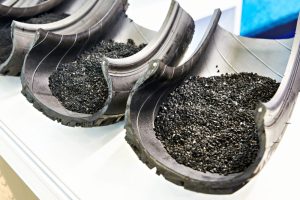
Crumb rubber is recycled rubber produced from automotive and truck scrap tires
Who is responsible for recycling end-of life tires?
In the past, that burden fell to municipal landfills to dispose of old tires. Now, there are over 400 jurisdictions around the world, with about 80 in Canada, that follow an Extended Producer Responsibility (EPR) and/or Individual Producer Responsibility (IPR) model.
This is an environmental policy that makes producers responsible for the entire life cycle of the products they sell into the market, to their end of use/life (including waste collection and recycling). Under EPR/IPR regulations, obligated companies must mitigate the environmental impacts of their products throughout the entire product lifecycle.
Here in Ontario, we have been proudly recycling tires for over a decade. The Ontario tire recycling management system officially changed to an Individual Producer Responsibility (IPR) model in 2019 with the enactment of the Tire Regulation (O.Reg 225/18) under Ontario’s Resource Recovery and Circular Economy Act (RRCEA). Simply put, the goal of the regulation is to keep Ontario’s scrap tires out of landfills, inspire innovation within the industry, support a circular economy and protect our environment.
Tune into our next blog as we explain why change continues to be par for the course as Ontario adapts to RRCEA and IPR. We will examine the innovations that might shape the next few years.
As a PRO, eTracks supports producers by managing the flow, recycling and re-purposing of used tires, from source to end point. We manage a complex supply chain of thousands of service providers, like All Ontario Recycling, to ensure producers remain compliant with regulations and support a more circular economy. Interested in how resource recovery, tire recycling and the circular economy works? Visit our resources page.
